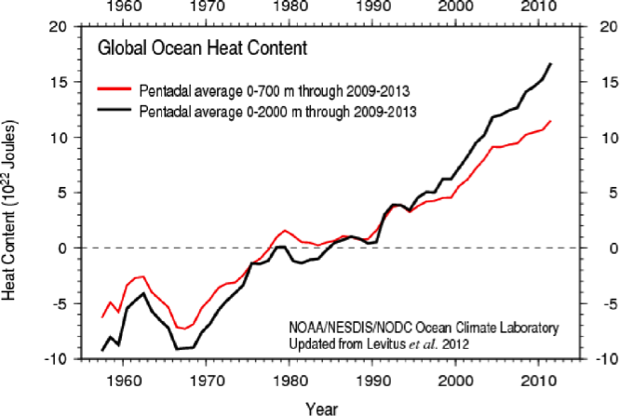 Ocean heating data from the National Oceanic and Atmospheric Administration.
Ocean heating data from the National Oceanic and Atmospheric Administration.Human emissions of greenhouse gases cause the Earth to warm. We’ve known that for decades – actually for over 100 years. But how do we measure warming? How fast is the planet heating? Turns out, this is conceptually easy to answer, even though it is difficult to implement the required measurements.
In order to measure how fast the planet is heating, we can measure the difference in incoming and outgoing energy at the top of the atmosphere (just like keeping track of a bank account by comparing deposits to withdrawals). Another way to measure a warming planet is to simply to measure how much energy is stored within the planet’s climate (like watching the balance of a bank account). Both methods should give the same answer. If you have more deposits than withdrawals to a bank account, you will see your balance increase.
Fortunately both of these methods, when used by climate scientists, tell the same story. The Earth is out of balance; we are gaining 0.5 – 1 Watts per square meter of area.
Okay, so what are the impacts of this heat? What should we experience? The answers to these questions were addressed in a recent paper (Abraham, Fasullo and Laden) published by the National Center for Science Education. This paper, which is geared toward an informed but not expert audience, focuses on the current energy imbalance, the recent trends in atmospheric temperatures, and the issue of the so-called “pause” of global warming. As a spoiler, we show that the “pause” is not really a thing.
First, there has been no pause or even slowdown in the warming of the planet. We provide updated information from NOAA which clearly shows a continued heating of the world’s oceans – the reservoir where most heat ends up. We compare energy contained in different layers and discuss the transfer of energy from the surface regions to the lower regions. When you look at the oceans, the so-called pause is simply a redistribution, a burying of heat to deeper waters.
 Ocean heating data from the National Oceanic and Atmospheric Administration.
Ocean heating data from the National Oceanic and Atmospheric Administration.
So, why is more heat being stored in the deep oceans? The leading idea is that changes to Pacific winds have created a temporary condition which resembles a La Niña event. The conditions are characterized by a cool pool of water in the Pacific as winds push water from the coast of South America toward Australia. This trend in Pacific water temperatures is alternatively called the Interdecadal Pacific Oscillation (IPO) or the Pacific Decadal Oscillation (PDO).
The important thing is, this oscillation is partly (perhaps mainly) natural and it doesn’t last forever. At some point, it will end and heat which was being buried in Pacific waters will end up elsewhere.
People who are interested in this are also watching patterns of atmospheric pressure and flow in the Pacific. Of particular importance is sea-surface winds which are updated daily here. If the winds switch and begin flowing from west to east, we will see a pickup in Pacific temperatures and a potential El Niño. If that occurs, we can expect 2015 to likely be the hottest year in recorded history.
Another thing to watch is the Southern Oscillation Index (SOI). Daily values are located here. The SOI is a measure of the difference in pressure anomalies between Tahiti and Darwin, Australia. According to the Australian Bureau of Meteorology,
the SOI gives an indication of the development and intensity of El Niño events. The SOI is calculated using the pressure differences between Tahiti and Darwin. Sustained negative values of the SOI below −8 often indicate El Niño episodes. These negative values are usually accompanied by sustained warming of the central and eastern tropical Pacific Ocean, a decrease in the strength of the Pacific Trade Winds.
Now, I am not saying that El Niño/La Niña cycles are also identified as PDO or IPO cycles. The point I am trying to make is these wind patterns in the Pacific and surface water temperatures in the same region help dictate short-term and multi-year temperature fluctuations worldwide.
Posted by John Abraham on Thursday, 11 December, 2014
 |
The Skeptical Science website by Skeptical Science is licensed under a Creative Commons Attribution 3.0 Unported License. |